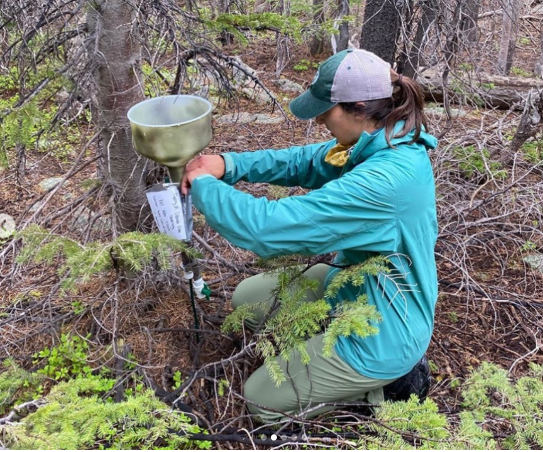
Isotope ecology: uncovering the unseen
Contributed by Katherine Rocci, PhD student in Graduate Degree Program in Ecology and Soil and Crop Sciences/NREL
Everyone who took a high school chemistry class learned that nitrogen, by definition, has a molecular weight of 14. But, what if I told you that is not always true? In fact, we can use variation in the weight of nitrogen to solve ecological mysteries!
Welcome to the field of isotope ecology, where we can uncover hidden processes or learn about human influence on ecosystems, all by looking at the weight of elements. Isotopes are elements that are the same in all respects but one: their weights. I spend a lot of my time thinking about nitrogen isotopes. Nitrogen is an incredibly important element for growing plants, and especially crops, but when lost from plants and soil to the atmosphere or waterways, can have devastating effects. Nitrogen lost to the atmosphere as nitrous oxide contributes to climate change, whereas nitrogen lost to the water can cause algal blooms that deplete the water of oxygen and lead to the death of aquatic life. So, understanding how nitrogen moves through ecosystems is important! But, how exactly do scientists do that? This is where isotopes can help!
Uses of isotopes
First, some basics. Nitrogen isotopes come in two forms; 14N, which is a nitrogen molecule that weighs 14 grams per mole, and 15N, which is a nitrogen molecule that weighs 15 grams per mole. 14N is much more common than 15N, with 99.6% of nitrogen in the environment being 14N and only 0.4% being 15N. In addition to these large differences in abundance, these different types of nitrogen also act differently during chemical processes. Some processes favor 14N and some prefer 15N. We can use these preferences to understand what is happening in the system. There are two main ways to use isotopes in ecology; natural abundance and labeling.
Natural patterns of isotopes
When we use natural abundance techniques, we are taking advantage of natural patterns of 14N and 15N. One way I am using natural abundance techniques in my research is by sourcing nitrogen pollution based on its amount of 14N and 15N. Rocky Mountain National Park (RMNP) has seen a doubling in visitation in the past 30 years. Consequently, more cars are being driven through the park, and those cars emit nitrogen that may be polluting roadside ecosystems in RMNP. Nitrogen from cars has a slightly depleted signal, meaning it has slightly less 15N than average, whereas nitrogen from other sources, like agriculture and coal combustion, are either very depleted, with much less, or very enriched, with much more, 15N than average. So, I am collecting nitrogen pollution in the air along a transect moving away from the road in RMNP. This nitrogen in the air eventually falls to the land surface, a process known as nitrogen deposition. If we see an increase in nitrogen pollution overall and slightly depleted nitrogen isotopic signal near the road, we can assume that nitrogen pollution from cars is depositing in roadside ecosystems in RMNP. We can then determine whether this nitrogen is affecting the roadside ecosystems, and if it is, can communicate this to RMNP, who can reduce nitrogen pollution from cars by encouraging bus usage and reducing the number of cars allowed in the park.

Adding extra isotope
When we use labeling techniques, as opposed to natural abundance techniques, we add extra 15N to the system. Because 15N is so rare naturally, we are able to find the added 15N even after it has been transformed. For example, in one of my research projects we wanted to understand how a sustainable product, called biochar, added to agricultural lands, affected fertilizer nitrogen cycling. We knew biochar was able to store carbon in the soil, which helps mitigate climate change, but wanted to see whether it could also help keep more fertilizer nitrogen in the plants and soil, rather than that nitrogen being lost to the groundwater or the atmosphere where it could then cause ecological harm. We wanted to specifically look at what happened to the fertilizer, rather than all of the nitrogen in the soil, since farmers have control over how much fertilizer they add. So, we added extra 15N to the fertilizer and then searched for the 15N in the soil and plants as part of a greenhouse project to see how much of it remained in the system. We found that about 20% of the added nitrogen was lost from the system without the biochar whereas about 30% of nitrogen was lost with the biochar, suggesting biochar may lead to more fertilizer nitrogen loss and thus was not beneficial with regard to nitrogen cycling in our system. Without the isotope labeling, we would not have been able to determine whether fertilizer nitrogen or soil nitrogen was being lost and would not have been able to provide actionable recommendation to farmers.

Isotopes are powerful ecological tools
Out of the many tools we use in ecology to understand the world around us, isotopes are one of the best because they give us the power to understand where elements come from and where they go. The ability to track elements through systems can help us understand questions across scales and fields of study, from the origin of the Earth to the impacts of industrialization. For me, isotopes have served as clues for how to better protect the environment. I encourage you to think about what isotopes could do for you!